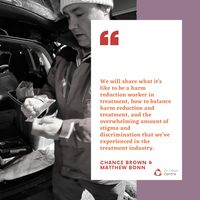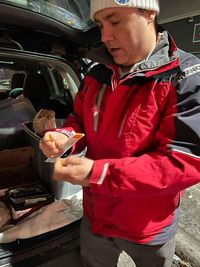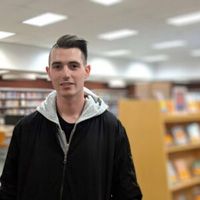People who currently, or formerly, use drugs make the best harm reduction advocates. They have so much personal experience and are some of the most thoughtful, caring, and compassionate people. They know what it’s like to be forced to use the toxic drug supply, be in constant fear of being arrested by law enforcement, and have never-ending stigma and discrimination by society and their social networks which they eventually internalize. People who use drugs who work on the frontline of this overdose crisis should be commended for the lives they are saving. All too often people who use drugs who work on the frontline experience immense amounts of burnout, grief, and trauma from this never-ending cycle of death that we live with.
There is nothing more valuable in this field than the current living experience of drug use, but being a former drug user with knowledge of overdose, incarceration, and treatment is a very appreciated form of experience as well. They know what it's like to go through the good times and bad times of drug use. People with that type of experience can help better navigate the tension between harm reduction and treatment, advocating for better services on both ends.
All aspects of the continuum of care for people who use drugs are extremely important from prevention, harm reduction, treatment, and education. People may go up and down the ladder of the continuum of care. For this piece, we will focus on two elements of the continuum: harm reduction and treatment. We will share what it's like to be a harm reduction worker in treatment, how to balance harm reduction and treatment, and the overwhelming amount of stigma and discrimination that we’ve experienced in the treatment industry.
First things first, what is Substance Use Disorder? Substance use disorder is a treatable, chronic disease; characterized by a problematic pattern of use of a substance leading to noticeable impairment. Substance use disorder often leads to overwhelming challenges in all aspects of someone's life. Patterns of symptoms resulting from substance use can help a doctor diagnose a person with substance use disorder and connect them to appropriate treatment.
A lot of people who use drugs will never develop a substance use disorder, but some people just can’t use drugs like other people. They typically suffer from various mental health issues such as anxiety and depression, and drug use acts as a solution for a long time before it becomes a problem. All aspects of the continuum of care are important, and we need to advocate for every part of it. We are two people who have worked in harm reduction and had it save our lives through overdose reversals and unconditional love. That being said, we still wanted to seek treatment for our substance use disorder. This certainly doesn’t mean that everyone who uses drugs should access treatment or that all harm reduction workers are people who use drugs.
The Centre for Disease Control defines harm reduction as a public health approach that focuses on mitigating the harmful consequences of drug use, including the transmission of sexually transmitted bloodborne infections, the prevention of fatal overdose, and the reduction of injection-related infections. Harm reduction programs are often initiated and operated by community-based organizations or health authorities and can include the provision of sterile syringes, naloxone distribution, comprehensive drug testing, and overdose prevention and education. According to the National Harm Reduction Coalition, harm reduction doesn’t have a set definition, but is rather a set of principles that people working with people who use drugs should follow. These principles are a set of principles we can all live with and should certainly be incorporated into treatment-based programs.
Managing a substance use disorder is not as simple as resisting the temptation to take drugs. It takes a lot of inner work and dedication. Like many other chronic conditions, treatment is available for substance use disorders. While no single treatment method is right for everyone, some people may need to seek abstinence-based treatment, and some people may need medication-assisted treatment, such as opioid agonist therapy using medications such as buprenorphine and methadone. Regardless, recovery is possible, and help is available for people with substance use disorders.
Treatment services and support can help people experiencing harm from substance use. Treatment isn’t designed for everyone who uses drugs, just people who have used drugs that have become a problem in their lives. Individuals must have autonomy over their own treatment and want to seek it out, not be forced to. These services can include early identification and intervention, harm reduction approaches, and relapse prevention. Services can also include peer support, specialized treatment, and continuing care. Some basic treatment services are typically available through public health, while others are in the private sector, monetizing from people's struggles. The privatized treatment industry is corrupt. People are charged a ridiculous amount of money to have someone dictate to them that they have a problem with substances. This is alarming as this exists at the same time as a political will to move money away from life-saving harm reduction services.
Some treatments are regulated according to rules, standards, and practices, while others have zero oversight. A lot of treatment services don’t carry naloxone, and people have died under their care that would have otherwise been saved if naloxone was available. This is a prime example of some treatment services not having any oversight or not following any rules. Understanding that there is no one-size-fits-all treatment option is essential to providing the best possible care. By matching people with services that fit their needs, they can have a better chance of recovery. Services and supports should be flexible and tailored to the needs of the individual to accommodate all people. They should also be acceptable, accessible, available, and affordable.
When seeking treatment for substance use, the main treatment model is abstinence-based. It’s an ideology. We are taught in harm reduction that we just need to reduce harms related to substance use, and our relationship with substances may change over time, so learning about abstinence-based ideology while in rehab was quite concerning to both of us. We were told we needed to cut our friends and colleagues who use drugs out of our lives. We were both questioned whether a career in harm reduction was worth our recovery. Due to our career choice, workers at our treatment centers asked if we were serious about changing our lives. It’s absurd that people think that former people who use drugs cannot ever be around drug use again or cannot navigate their careers. People in 12-step fellowships try to inflict their recovery on every person who uses drugs. Even though there is no hierarchical authority figure in 12-step fellowships a lot of people take on this role which is a huge turn-off for people seeking recovery.
We have both been very successful working in harm reduction and have just decided that we had to change our drug use, not that we need to change everyone else's drug use. Today, we can apply some of the tools we have learned in treatment to support people who are currently using drugs. Having the ability to cope with situations, reduce harmful drug use behaviours, and share our experiences entering treatment strengthens our perspective of harm reduction. It allows us to support people in a whole new way.
There are all kinds of opportunities for current or former people who use drugs. People with lived and living experience make the ideal candidate to be a perfect support person and help people in their substance use journey. Harm reduction services such as overdose prevention sites or supervised consumption sites, needle and syringe programs, shelters, withdrawal management services, or opioid agonist therapy clinics all need people with lived or living experience. There will always be an urgent need for responding to overdoses, harm reduction supply outreach, naloxone education, supporting people experiencing homelessness, or helping patients navigate the healthcare system. Harm reduction workers are extremely important to this work but often get exploited and experience a lot of burnout doing these jobs.
We have real-world experience in this field and are better suited to do this job than anyone else. The longer we are working in this field, the more skills and competencies we will develop to do these jobs. We may climb the harm reduction organization ladder and run an organization independently one day. Anything is possible when we use our lived and living experiences for employment. Everyone who uses drugs needs help in some capacity either trying to navigate the healthcare system, help with housing, or simple peer support.
A lot of treatment centers have arbitrary rules that restrict people early in treatment from working, especially in harm reduction organizations. It’s ludicrous that you're not allowed to work, and it completely goes against trying to be responsible, productive members of society. Another rule that treatment centers often place on people is that you're not allowed to go around active drug users, thinking they may be harmful to one's recovery. People who use drugs are some of the most supportive people out there, they know what it's like to be looked down upon and don’t try and perpetuate that kind of behaviour on anyone else.
If people want to stop using drugs for themselves and are willing to put the effort into achieving that then they should never be denied the freedom to work and support other individuals who are struggling. The whole treatment and recovery philosophy is helping other people. For some of us, that means we're going to help and support people who are actively using. It can help remind us what it was like to be in active use and help us stay committed and present in our recovery. Former drug users are really good harm reduction workers and need to be recognized and paid properly for their experience in the field.
People in the treatment industry should never forget where they came from. There is an overwhelming amount of stigma and discrimination that is perpetuated in the harm reduction field by people working in the treatment sector. They believe that everyone who uses drugs should seek out treatment and that no one actively using can have a good life. That is simply not true. Even though we have both sought out treatment and are trying to reduce, decrease, or even stop the amount of drugs we were doing, it doesn’t mean everyone using drugs should.
We both have a lot of experience working in harm reduction and seeking treatment and those two things don’t have to be mutually exclusive. All parts of the continuum are equally important and we must follow evidence-based guidelines. People who use drugs need to be recognized for their expertise. It's about time they received some recognition for all the work they have done.
By seeking treatment and from our experience working in the harm reduction field, our harm reduction philosophy and treatment ideology have grown to a new level of durability. We’ll be able to support people actively using, and if they ever want to try to reduce their drug use, we’ll be there to share our experience, provide resources, and list off tools. Treatment doesn’t need to be for everyone, but harm reduction does. Treatment is available if and when people want to seek it out but harm reduction needs to be there 24/7. Harm reduction saves lives. All we can do today is focus on meeting people where they are and not leave people behind.





